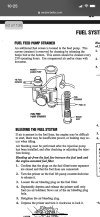Hi I am hoping you diesel/npr experts can help. We are getting fuel to the fuel filter and to the injection pump but not to the injectors. The fuel solenoid is getting power. Below is the whole story for context because we did get it to run.
2003 NPR sat for about a year, mechanic unstuck manual primer and got it primed and air out of system, using starter fluid we got truck running for about 3 minutes and it shut off going to the process a few more times we got it running for a good 20 minutes then truck would not shut off with the key but it finally did after a few tries. We were noticing that the fuel filter was not filling up completely maybe about 80%, (towed to diesel mechanic - not NPR guy) after changing the broken manual hand primer pump we are now getting lots of pressure to the fuel filter and injection pump but truck does not start and no fuel to injectors. I don't see him going through the same routine as the other guy bleeding air etc, he thinks it's not necessary maybe just to see it get fuel to the injectors.
Although the fuel solenoid has power could that still be the problem?
2003 NPR sat for about a year, mechanic unstuck manual primer and got it primed and air out of system, using starter fluid we got truck running for about 3 minutes and it shut off going to the process a few more times we got it running for a good 20 minutes then truck would not shut off with the key but it finally did after a few tries. We were noticing that the fuel filter was not filling up completely maybe about 80%, (towed to diesel mechanic - not NPR guy) after changing the broken manual hand primer pump we are now getting lots of pressure to the fuel filter and injection pump but truck does not start and no fuel to injectors. I don't see him going through the same routine as the other guy bleeding air etc, he thinks it's not necessary maybe just to see it get fuel to the injectors.
Although the fuel solenoid has power could that still be the problem?

